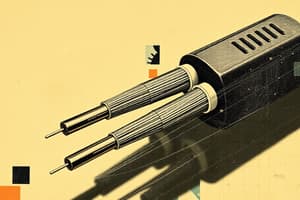Podcast
Questions and Answers
What are some factors to consider when choosing appropriate cable types?
What are some factors to consider when choosing appropriate cable types?
Bandwidth requirements, distance, and environmental factors
How can cable management techniques help in network maintenance?
How can cable management techniques help in network maintenance?
Organize and secure cables, minimize cable clutter, and facilitate troubleshooting
What standards should be followed for Ethernet cable termination?
What standards should be followed for Ethernet cable termination?
T568A/B
What is the purpose of testing cables using certification tools?
What is the purpose of testing cables using certification tools?
Why is it important to adhere to safety precautions when installing cables?
Why is it important to adhere to safety precautions when installing cables?
What is the significance of designing a suitable network topology?
What is the significance of designing a suitable network topology?
How can strategic cable routing help in maintaining signal integrity?
How can strategic cable routing help in maintaining signal integrity?
When should signal amplifiers or repeaters be considered in cable installations?
When should signal amplifiers or repeaters be considered in cable installations?
Why is proper grounding and shielding important in cable installations?
Why is proper grounding and shielding important in cable installations?
Flashcards are hidden until you start studying
Study Notes
Cable Installation and Management
- Select suitable cable types (e.g., Cat 5e, Cat 6, fiber optic) based on bandwidth requirements, distance, and environmental factors.
Cable Organization and Security
- Employ proper cable management techniques to minimize clutter, ease troubleshooting, and facilitate maintenance.
- Organize and secure cables to prevent damage and ensure reliable signal transmission.
Cable Termination and Testing
- Follow termination standards (e.g., T568A/B for Ethernet cables) to ensure consistent connectivity and compatibility.
- Test cables using cable testers and certification tools to verify cable integrity, continuity, and compliance with standards.
Safety and Precautions
- Adhere to safety precautions when installing cables, including proper handling of tools, equipment, and materials.
- Avoid hazards such as electrical wiring and sharp objects during cable installation.
Network Design and Topology
- Design a network topology that suits specific requirements (e.g., star, mesh, bus, or hybrid topology).
Cable Routing and Signal Amplification
- Route cables strategically to minimize interference, maintain signal integrity, and facilitate future expansion or maintenance.
- Consider using signal amplifiers or repeaters to maintain signal strength and quality over long cable runs.
Electromagnetic Interference (EMI) Prevention
- Implement proper grounding and shielding techniques to minimize electromagnetic interference (EMI) and ensure reliable signal transmission.
Studying That Suits You
Use AI to generate personalized quizzes and flashcards to suit your learning preferences.




